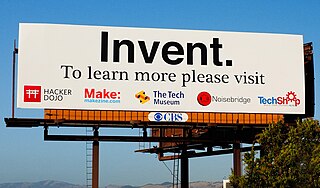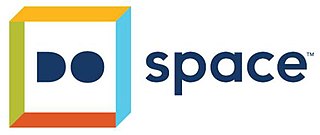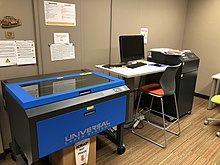
A public library is a library, most often a lending library, that is accessible by the general public and is usually funded from public sources, such as taxes. It is operated by librarians and library paraprofessionals, who are also civil servants.

A librarian is a person who works professionally in a library providing access to information, and sometimes social or technical programming, or instruction on information literacy to users.

A fab lab is a small-scale workshop offering (personal) digital fabrication.
Library 2.0 is a proposed concept for library services that facilitate user contributions and other features of Web 2.0, which includes online services such as OPAC systems. The term "Library 2.0" was coined by Michael Casey in 2006 on his blog Library Crunch.

The Public Library of Youngstown and Mahoning County has 15 branches that serve 10 communities in Mahoning County, Ohio.
Loudoun County Public Library (LCPL), with more than 200 employees, both professional and paraprofessional, serves the citizens of Loudoun County, Virginia. There are 10 physical branches, plus Outreach Services, which delivers books and other resources to the disabled, elderly and homebound.

Transliteracy is "a fluidity of movement across a range of technologies, media and contexts". It is an ability to use diverse techniques to collaborate across different social groups.
Markham Public Library (MPL) is a library system operated by the municipal government of the City of Markham in Canada. There are eight branches in the city, serving about 250,000 residents in Markham. The libraries are managed by the Administration Centre, located at 6031 Highway 7.

A hackerspace is a community-operated, often "not for profit", workspace where people with common interests, such as computers, machining, technology, science, digital art, or electronic art, can meet, socialize, and collaborate. Hackerspaces are comparable to other community-operated spaces with similar aims and mechanisms such as Fab Lab, men's sheds, and commercial "for-profit" companies.

TechShop was a chain of membership-based, open-access, do-it-yourself (DIY) workshops and fabrication studios. As of 2017 they had ten locations in the United States: three in California, one in Arizona, one in Arlington, Virginia, one in Michigan, one in Texas, one in Pittsburgh, Pennsylvania, one in St. Louis, Missouri, and one in Brooklyn, New York, as well as four international locations.
With over 17,000 libraries and 2.5 billion materials circulated annually in the United States alone, libraries are a ubiquitous part of the American landscape. However, as libraries modernize, they face an increasingly harsh budget environment, as well as technological disruption in media, scholarship, and education. The political, social, and technological environment is one of transformation and uncertainty.

The maker culture is a contemporary subculture representing a technology-based extension of DIY culture that intersects with hardware-oriented parts of hacker culture and revels in the creation of new devices as well as tinkering with existing ones. The maker culture in general supports open-source hardware. Typical interests enjoyed by the maker culture include engineering-oriented pursuits such as electronics, robotics, 3-D printing, and the use of computer numeric control tools, as well as more traditional activities such as metalworking, woodworking, and, mainly, its predecessor, traditional arts and crafts.

The Pasco County Library Cooperative (PCLC) is the public library system that serves all residents of Pasco County, Florida, and is a member of the Tampa Bay Library Consortium. The Pasco County Library System, as it was originally known, was established by county ordinance in 1980.

The Brevard County Library System is a public library system in Brevard County, Florida that coordinates activities between its member public libraries, which collectively serve Brevard County. It is composed of 17 distinct branches stemming all the way from Mims to Micco, with the central administrative and largest of these libraries being the Catherine Schweinsberg Rood Central Library in Cocoa, Florida. It is governed by a board of trustees appointed and funded by the Brevard County Board of Commissioners. Its missions statement is "Brevard County Libraries enables people of all ages to improve their quality of life by providing information and enrichment through traditional resources and new technology." Its vision statement is "We will be recognized as a Library System that excels in providing efficient, modern, accessible and customer oriented services."

Repair Café is an organisation with venues setup to provide people with a place to gather and work on repairing objects of everyday life, such as electronics, mechanical devices, computers, bicycles, and clothing. Repair Cafés are typically held at community locations including churches, libraries, and college campuses where tools are available and device owners can fix their broken goods with the help of volunteers. Repair Café is a part of the grassroots movement that aims to reduce waste, overconsumption, and planned obsolescence. It can re-ignite the do-it-together and "do it yourself" spirit and strengthen social cohesion.
The Gold Coast Techspace is a Hackerspace and Makerspace focusing on electronics, computer programming, and 3D printing. It is currently located at the Mudgeeraba Old Post Office, Mudgeeraba, Gold Coast, Queensland, Australia.

Do Space is a 501(c)(3) non-profit community center for technology, digital library, education, and small makerspace featuring 3D printing technology in Omaha, Nebraska.

The Clearwater Public Library System (CPLS) is a public library system with five branches that provides service to the citizens of Clearwater, Florida and Pinellas County. The library system was founded in 1911. It is a member of the Pinellas Public Library Cooperative.
Maker education closely associated with STEM learning, is an approach to problem-based and project-based learning that relies upon hands-on, often collaborative, learning experiences as a method for solving authentic problems. People who participate in making often call themselves "makers" of the maker movement and develop their projects in makerspaces, or development studios which emphasize prototyping and the repurposing of found objects in service of creating new inventions or innovations. Culturally, makerspaces, both inside and outside of schools, are associated with collaboration and the free flow of ideas. In schools, maker education stresses the importance of learner-driven experience, interdisciplinary learning, peer-to-peer teaching, iteration, and the notion of "failing forward", or the idea that mistake-based learning is crucial to the learning process and eventual success of a project.

SteamHead is a non-profit organization whose stated goal is to "increase the presence of design in education". SteamHead claims inspiration from the Maker movement and S.T.E.A.M. education. Initiatives credited to SteamHead aim to help communities increase their capacity to "make". Activities are supported sponsors including the British Council, local charities, and schools. The organization supports local events including MakeFashion Edu and School Maker Faires.
















